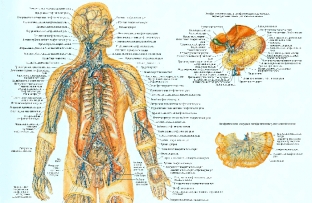The human lymphatic system is a kind of sewerage of the body – it is in the vessels of the lymphatic system that all pathogenic particles enter and are neutralized. The human lymphatic system consists of several links of the lymphatic vascular bed: capillaries, vessels, ducts, lymphatic trunks and nodes, which are filled with liquid contents – lymph.
The human lymphatic system performs a cleansing, evacuation, barrier, lymphogenesis and immune function, and if any pathology of the lymphatic system develops in the body – the normal functioning of the entire human body is disrupted.
Lymphatic capillaries and vessels: structure and functional features
Lymphatic capillaries are the smallest part of the lymphatic system. They clean the tissues of the body from products that are not able to penetrate into the bloodstream. The diameter of the lymphatic capillaries is somewhat larger than the diameter of the blood capillaries, and they are absent in the brain, the epithelial lining of the skin and mucous membranes, the placenta, some structures of the spleen, kidneys, liver and eyes.
Lymphatic capillaries do not have a basement membrane and consist only of endothelial cells with large gaps between them – thus, foreign bodies and high molecular weight proteins enter the lymph flow. All lymphatic vessels are divided into superficial and deep. They have muscle cells and valves in their structure, with the help of which lymph flow is directly provided.
Lymphatic ducts and trunks: location and functions
In the human body, there are two lymphatic ducts: the thoracic and right lymphatic, which are larger in structure than lymphatic vessels. Thoracic duct begins at the level of the 1st lumbar vertebra and is formed by the fusion of two trunks: the left and right lumbar.
It rises to the level of the 7th cervical vertebra, where it flows into the left venous angle. Before that, the left bronchomediastinal, subclavian and jugular lymphatic trunks flow into the thoracic stream. The thoracic duct collects lymph from the lower half of the body, the left arm, the left half of the head, neck and chest, as well as the organs located in its cavity.

The right lymphatic duct flows into the right venous angle and is formed by the confluence of the right bonchomediastinal, subclavian and jugular lymphatic trunks. It collects lymph from the right hands, the right side of the head, neck, chest and organs located in it.
Human lymph nodes: classification by location
All the lymph nodes of the human body form more than 50 groups and are divided into three categories:
- somatic – nodes that collect lymph from the body and limbs;
- visceral – collecting lymph from internal organs;
- mixed – collecting lymph, both from the internal organs and from the organs of movement.
Flowing through the lymph nodes, the lymph is cleared of all unnecessary particles and microbes, and enriched with cellular elements. It is in the lymph nodes that immune bodies are produced, and lymph is deposited there. In the head region, occipital, parotid, mental and submandibular groups of lymph nodes are isolated.
In the neck area there are lateral nodes, which are located on the sternocleidomastoid muscle and deep, forming three chains along the internal jugular vein. They receive lymph from the skin, muscles, and bones of the head and neck. Regional lymph nodes of the upper limb – elbow and axillary, collect lymph from all structures of the arm and palm.
The axillary lymph nodes are the most important lymph nodes in the upper limb, as they collect lymph from the mammary gland. There are also regional lymph nodes in the lower extremities – popliteal and inguinal, which are divided into superficial and deep groups of lymph nodes. All splanchnic lymph nodes are named according to the organs from which they receive lymph.
In the abdominal cavity, pancreatic, hepatic, splenic lymph nodes and so on are isolated, in the pelvic cavity – periuterine, periurinary lymph nodes and others.
How the human lymphatic system reacts to the pathological process
The lymphatic system immediately responds to any pathological process that occurs in the body. Her very first reaction is an increase in lymph nodes. It is important for practicing doctors to remember that in a healthy body only a slight increase in the submandibular and inguinal lymph nodes is acceptable – no more than 1-2 cm, depending on which groups of lymph nodes are enlarged, one or another pathology can be assumed.
For example, an increase in the lymph nodes located around the auricles is characteristic of such an infectious disease as rubella. Enlarged supraclavicular lymph nodes may indicate tuberculosis or stomach cancer, axillary – breast cancer, inguinal – about the inflammatory process in the genitourinary system and so on. The most terrible diseases of the 21st century – cancer and HIV infection also specifically affect the lymphatic system.
For HIV infection, an increase in all groups of lymph nodes is characteristic, while in cancer, palpation of the lymph nodes is determined in the form of soldered, dense conglomerates, which is directly related to metastasis.







Add a comment